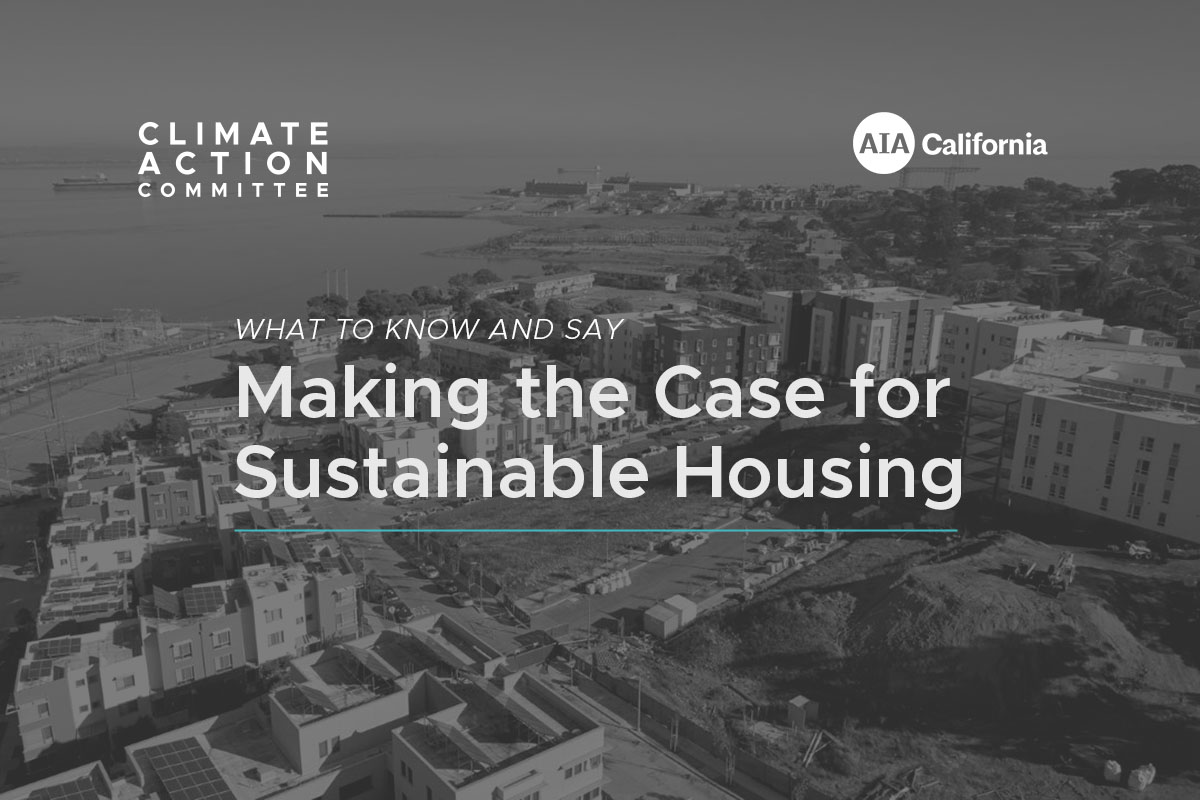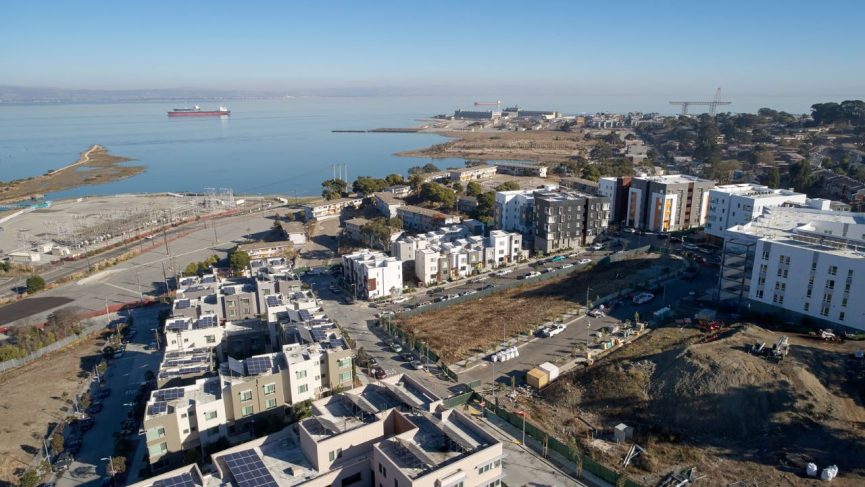
Sustainable affordable housing as a concept has been a popular topic for many years. Who among us is “against” building housing to a standard that provides viable homes for all people and also reduces resource consumption? Affordable, sustainable housing is key to living a stable life because it means benefits such as improved health, comfort, resilience, and reduced operating and utility costs. I for one have not encountered anyone who thinks aiming for these goals is bad, misguided, or narrow-minded.

And yet there is a persistent— largely unspoken—tension between the development work of people who are driven to solve the housing crisis and the sustainability approach of those who are dedicated to addressing and arresting climate impacts. Our clients, almost without exception, generally presume that sustainable design “costs more” and if you say otherwise you’re probably not telling the whole truth. Mission-aligned non-profit developers demur on sustainability talk, always willing to “do what they can within the budget,” and are very perceptive to being sold something extra by “Team Sustainability”.
This perceived conflict between affordability and sustainability occurs at every level. In 2020, the California Tax Credit Allocation Committee (TCAC) eliminated “Sustainable Building Methods” from its affordable housing development requirements, citing improved statewide codes—the Energy Code (Title 24) and the Green Buildings Code (CalGreen) and the “added cost” of going beyond. Per TCAC, every dollar should be spent on building homes: In other words, any level of sustainable design beyond what is required is non-essential.
But we know that a decent home is more than just four walls and a roof, and the current code is not designed to safeguard essentials of housing quality. Here are some examples of top development priorities for housing that I have found in my own experience to be neither required nor regularly prioritized in affordable housing: acoustic privacy, adaptability to extreme weather, a check on unregulated toxic chemicals that pose acute health risks, and, most importantly, contractor accountability. Those seem pretty essential.
A New Frame
So why the continued tension? We can certainly lay some blame on our culture of short-term thinking, where development and finance policy keep us from looking at the true long-term costs associated with different levels of housing quality —even over a relatively short time span of 10 to 15 years—thereby maintaining status quo practices (and preserving status quo inequities).
But, if designers and industry advocates for sustainability keep finding ourselves in the middle of a debate about whether sustainability is “essential,” perhaps it is a red flag that we are not successfully communicating the essential concept of sustainable design.
We on “Team Sustainability” are used to a “better buildings” mindset and narrative: Buildings account for 40% of global greenhouse gas emissions, and it’s our ethical obligation to reduce environmental impact through design—which by the way is also good for people and good for business—so win-win-win!
There is nothing wrong with this way of thinking, and I applaud developers who have hit the triple-bottom-line jackpot. But the fact is this narrative doesn’t often stick the landing with housing developers, even the most conscientious and mission-driven ones.
Part of the disconnect is our failure to recognize that the power of housing providers to engage in climate action starts locally, in securing and expanding the direct benefits of economic stability, health, and adaptation to the communities where they operate.
This is a subtle rhetorical shift but an important one, not just for housing but for any project type where the marketability of green building is not driving decision-making. Here are some strategies we have found to guide more meaningful integration of sustainable design across our practice:
Step 1. Develop your own stance on sustainable design within your practice area. Although our clients hire us for our commitment to sustainability, they don’t often like to be “sold” on a particular certification or commitment. Our clients want us to come to the table with the right answer for their site and program, based on our professional experience. Therefore, if we want to advocate for sustainable design, it must be endemic to our practice. This requires knowing that your core design principles point you toward sustainable solutions, and that these are ultimately informed by a culture of tenacious curiosity, observation and learning. While certifications and frameworks are a great accountability tool, they are not a good tool of persuasion or new thinking.
In updating our sustainability action plan last year, we began honing a new set of questions we think are most critical. Instead of asking “how can we achieve a zero carbon building?” or “how can we repair ecologies?” We have begun to ask “how can this building improve places and lives?” And collecting some creative answers in partnership with our clients.
In re-examining our own stance, we no longer have to “make the case” to clients. We are simply coming to them with a better version of the “right answer” they wanted from us all along.
Step 2. Listen to and understand the client’s priorities. Try talking about owner’s project requirements in terms of service needs rather than spaces or components. How will this project serve the needs of residents when it comes to basic things like food and water access, thermal control and clean air, digital communications, mental health and stress reduction, child care and play space, to name a few? What is the functional need on a normal mode and what does the client need preserved during a critical disruption? To understand the day-to-day demands on staff, operators and asset managers, a walk with all stakeholders to existing properties creates the perfect opportunity to listen and start a shared dialogue. Likewise, if you propose a dedicated meeting about “resilience planning” or “universal design” you have already potentially set this conversation apart from the normal design process.
Step 3. Lead with a project vision. A housing project always has something powerful it can say about the surrounding community, ecological history, and future outlook. A strong foundational idea has the best chance of attracting and retaining good design decisions, regardless of whether it begins with the typical conventional wisdom about massing and orientation. I encourage our staff to set aside their assumptions about what sustainable design is supposed to look like, and instead lean into and expand upon the insight they had about how this project could make the community better.
Step 4. Set the tone of a mutual learning process where all members of the broader design team are empowered to speak up with opportunities to improve performance. Many of our subconsultants “stay in their lane” and react to our architecture unless explicitly asked to bring up opportunities for greater economy or robustness. Establishing this expectation directly at a kick-off meeting has completely shifted the tone of our projects.
Similarly, adopt an attitude of co-exploration with the client when it comes to new technology. We’re learning about the possibilities of this together because we both understand the bottom line is livable housing. As a design consultant, it is easy to get into the position of making a pitch for promising solutions. But this can create distance between the client and Team Sustainability.
Step 5. Have courageous conversations. Even if your bet is on the project getting stripped down to being not much more than “four walls and a roof” due to cost containment, this does not preclude you from having conversations! Every time you are willing to have a conversation – whether it’s exploring water or energy resilience or eliminating harmful chemicals and combating plastic building syndrome, you move your own understanding and your client’s forward in a way that may benefit future projects if not the current one.
Centering sustainable design on social equity and the experience of inhabitants is not just a popular thing to say these days. It actually widens your view and can lead to a potentially more meaningful harvest of low-cost, high-impact design measures, for example free internet, carbon-free mobility, open space with tangible health benefits, control interfaces that improve understanding and ease, and resident service programs that serve as a vehicle for enhanced resilience. Harvesting these opportunities doesn’t happen without opening a deliberate conversation.
Step 6. Don’t go soft on the metrics internally, but they don’t have to drive the show. Leverage the AIA Framework for Design Excellence to push stronger in-house evaluation of portfolio performance. Use it to expand literacy among staff, and show off your intellectual curiosity to your clients, sharing the wins and the discoveries.
Finally, grow partnerships into broader action. Work with clients to shift the conversation at the policy and industry level, from how funding requirements and grants are structured, to how owners talk about the goals of a project with design teams and builders. Sustainable housing is one of the best investments a society can make. Where are we if we have to fix and reconstruct housing in 15 years because it failed to address an entirely predictable and acute adaptation need? If we allow a branded concept like “zero carbon building,” to drive advocacy and define success, we run the risk of overlooking a building’s less obvious social and community contributions to climate and thereby risk diminishing livable density; failing to fully catalyze opportunity, health, and resilience; making investments that have limited return to inhabitants; or burdening housing providers with an undue responsibility for innovation or collective infrastructure. Instead we want to work with our clients to interrogate what ambitious climate action looks like for our projects, and build a shared commitment to deliver on those ambitions.
Katie Ackerly, AIA
Katie Ackerly, AIA, is Principal and Sustainable Design Director at David Baker Architects, an award-winning firm known for elevating the design of multi-family housing. Katie came to architecture from a background in building science and energy efficiency policy, and holds a Master of Architecture and a Masters degree in Building Science from UC Berkeley.